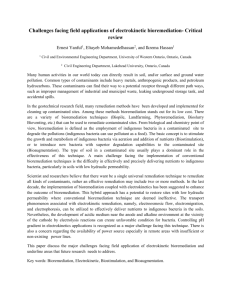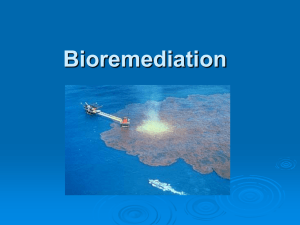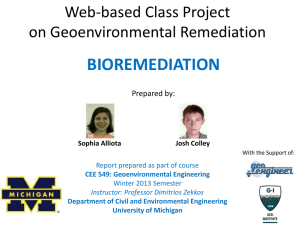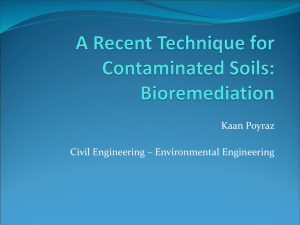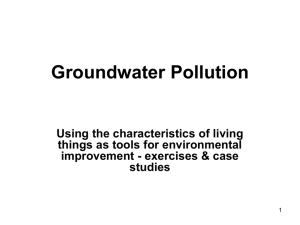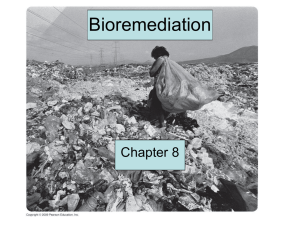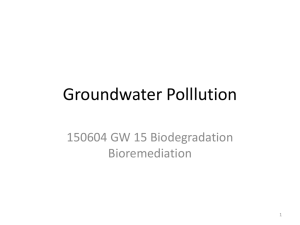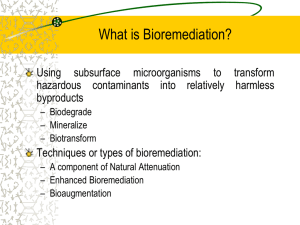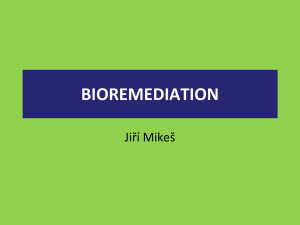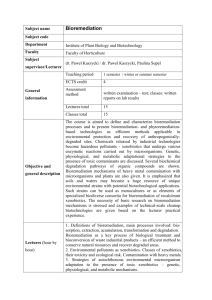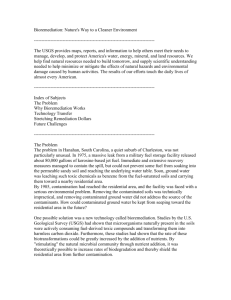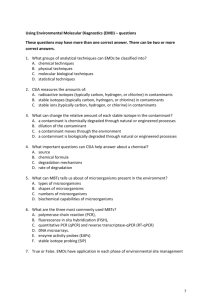Enzymes in biodegradation
advertisement
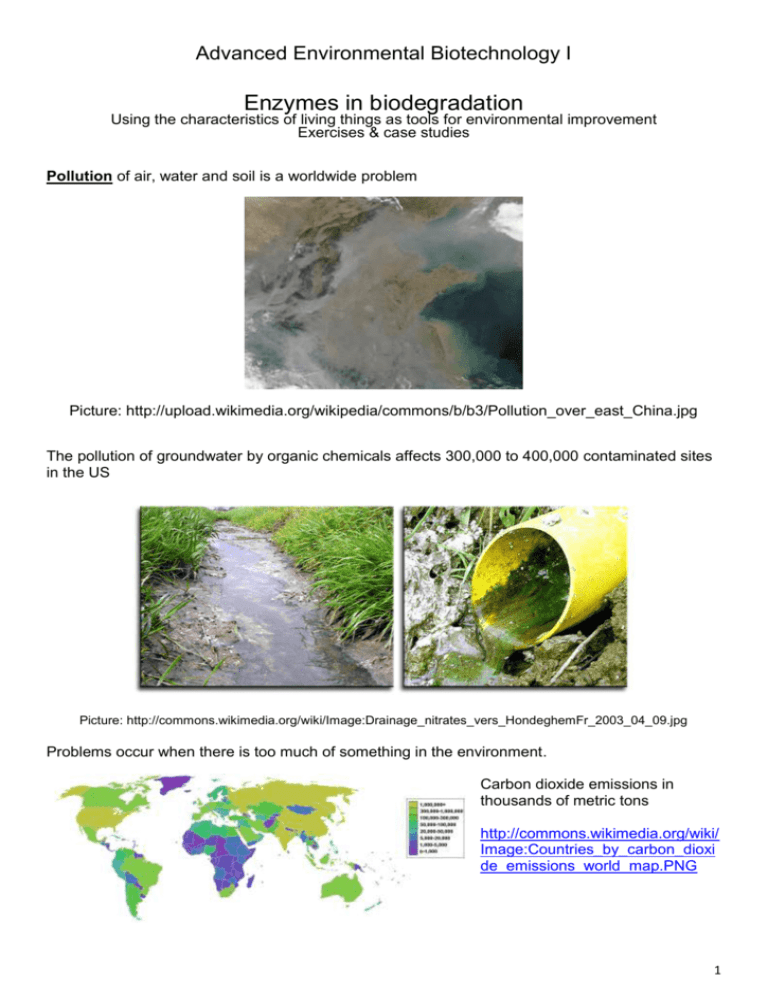
Advanced Environmental Biotechnology I Enzymes in biodegradation Using the characteristics of living things as tools for environmental improvement Exercises & case studies Pollution of air, water and soil is a worldwide problem Picture: http://upload.wikimedia.org/wikipedia/commons/b/b3/Pollution_over_east_China.jpg The pollution of groundwater by organic chemicals affects 300,000 to 400,000 contaminated sites in the US Picture: http://commons.wikimedia.org/wiki/Image:Drainage_nitrates_vers_HondeghemFr_2003_04_09.jpg Problems occur when there is too much of something in the environment. Carbon dioxide emissions in thousands of metric tons http://commons.wikimedia.org/wiki/ Image:Countries_by_carbon_dioxi de_emissions_world_map.PNG 1 Bioremediation is when organisms either metabolize or fix contaminants Bioremediation is any process that uses microorganisms, fungi, green plants or their enzymes to return the contaminated environment to its original condition. Because there is too much of something we need to either reduce it or immobilize (fix) it Other Names Bioremediation is also called enhanced (늘리다) bioremediation or engineered bioremediation. Aerobic bioremediation usually involves oxidative processes Contaminants may be partially oxidized to less toxic things Contaminants may be fully oxidized to chemicals such as carbon dioxide and water BTEX (Benzene, Toluene, Ethylbenzene, and Xylenes) are monoaromatic hydrocarbons which are in petroleum and petroleum products such as gasoline. 2 If there is enough oxygen more degradation can happen If there is enough oxygen they can degrade to water and carbon dioxide 2C6H6 + 15O2 12CO2 + 6H2O 3 The organisms make chemical reactions happen Balance these reactions Benzene (a component of gasoline) 2C6H6 + 15O2 ?CO2 + ?H2O Alanine (an amino acid) 4C3H4NH2O2H + 15O2 12CO2 + 14H2O + ? Benzene (a component of gasoline) 2C6H6 + 15O2 12CO2 + 6H2O Alanine (an amino acid) 4C3H4NH2O2H + 15O2 12CO2 + 14H2O + 2N2 These chemical equations are used to calculate how many other chemicals need to be added. 150 kg of analine needs to be degraded. How much oxygen needs to be supplied? Atomic weights N=14 O=16 H=1 C=12 C3H4NH2O2H = 89 4C3H4NH2O2H needs 15O2 150 / 89 x 4 = X / 32 x 15 X = 202 kg O2 4 Bioremediation might be improved We could add more or better organisms to the soil (bioaugmentation) We could help the organisms grow by changing things in the environment (biostimulation) How could we stimulate the growth of microorganisms? We could add nutrients, change the pH, change the temperature, and add or remove oxygen. Eg Benzene 2C6H6 + 15O2 12CO2 + 6H2O We can engineer the conditions Engineered bioremediation involves supplying oxygen (or other electron acceptor), water, and nutrients at the correct rate so that the naturally existing microorganisms are stimulated to degrade the contaminants. Microbial biodegradation of pollutants occurs most rapidly under certain optimal conditions: Temperature (15-30 C) High moisture content High oxygen content Nutrient availability Usually neutral pH (~7) Constant ionic strength Absence of toxic inhibitors 5 Biotechnological plants try to maintain optimal conditions for micro-organisms How can we follow what is happening? Signs of Biological Activity Biological activity will result in decreased oxygen concentration (for aerobic processes) and increased metabolites (e.g. CO2). Types of Contaminants Bioremediation is commonly used for: Organic contaminants Some inorganic pollutants such as ammonia, nitrate, and perchlorate Changing the valence states of heavy metals to convert them into immobile or less toxic forms. (eg mobile hexavalent chromium into immobile and less toxic trivalent chromium) Perchlorates are the salts of perchloric acid (HClO4). They are commonly found in rocket fuel and explosives, often those used by the military. Advantages of Bioremediation It may result in complete degradation of organic compounds to nontoxic byproducts. Not much equipment is needed Bioremediation does not change the natural surroundings of the site. Low cost compared to other remediation technologies. Advantage 우위 Toxic ≠ nontoxic (not toxic) equipment 설비 6 Disadvantages of Bioremediation There could be partial degradation to metabolites that are still toxic and/or more mobile in the environment. Biodegradation is easily stopped by toxins and environmental conditions. We have to always measure biodegradation rates. Generally requires longer treatment time as compared to other remediation technologies. Partial 불완전한 Mobile 가동성의 Rate 속도, 진도 Bioremediation processes may give: complete oxidation of organic contaminants (called mineralization), biotransformation of organic chemicals into smaller parts, or reduction of halo- and nitro- groups by transferring electrons from an electron donor (eg a sugar or fatty acid) to the contaminant, resulting in a less toxic compound. Usually electron acceptors are used by bacteria in order of their thermodynamic energy yield: oxygen, nitrate, iron, sulfate, carbon dioxide. The major nutrients needed include carbon, hydrogen, oxygen, nitrogen and phosphorous. The amount which needs to be added depends on what is already there. Generally, the C to N to P ratio (w/w) required is 120:10:1. Bioreactors are biochemical-processing systems designed to degrade contaminants using microorganisms. Contaminated water flows into a tank, where microorganisms grow and reproduce while degrading the contaminant. The biomass produced is then separated from the treated water and disposed of as a biosolids waste. This technology can be used to treat organic wastes (BOD), ammonia, chlorinated solvents, propellants, and fuels. Artificial wetland ecosystems (organic materials, microbial fauna, and algae) can remove metals, explosives, and other contaminants from inflowing water. The contaminated water flows into the wetland and is processed by wetland plants and microorganisms to break down and remove the contaminants. 7 Bioremediation (김동진 교수) Bioremediation relies on microorganisms to biologically degrade groundwater contaminants through a process called biodegradation. It may be engineered and accomplished in two general ways: (1) stimulating native microorganisms by adding nutrients, oxygen, or other electron acceptors (a process called biostimulation); or (2) providing supplementary pregrown microorganisms to the contaminated site to augment naturally occurring microorganisms (a process called bioaugmentation). It mainly focuses on remediating organic chemicals such as fuels and chlorinated solvents. One approach, aerobic bioremediation, involves the delivery of oxygen (and potentially other nutrients) to the aquifer to help native microorganisms reproduce and degrade the contaminant. Another approach, anaerobic bioremediation, circulates electron donor materials—for example, food-grade carbohydrates such as edible oils, molasses, lactic acid, and cheese whey—in the absence of oxygen throughout the contaminated zone to stimulate microorganisms to consume the contaminant. In some cases, pregrown microbes may be injected into the contaminated area to help supplement existing microorganisms and enhance the degradation of the contaminant, a process known as bioaugmentation. Bioremediation can be used to treat groundwater and landfills Bioremediation Bioreactor 8 Phytoremediation Selected vegetation reduces, removes, and stops the toxicity of environmental contaminants, such as metals and chlorinated solvents. What does Phytoremediation do? In Situ Phytoremediation System Aerobic is often faster than anaerobic degradation However, many compounds can only be metabolized under reductive conditions. Then anaerobic metabolism is needed. One type of anaerobic bioremediation is reductive dehalogenation where the contaminants are made less toxic by removal of halogens such as chlorine or nitro groups. 9 Degrading of tetrachloroethene Anaerobic = no oxygen Tetrachloroethene is reduced with eH2 is the electron donor 10 At many contaminated sites, organisms naturally exist that can degrade the contaminants But not all sites have organisms that work. Some sites don’t have the right conditions (such as electron acceptors) for fast degradation of the contaminants. In methanogenic bioremediation, the contaminants are converted to methane, carbon dioxide and traces of hydrogen. Energetics In order for energy to be released from an oxidation/reduction reaction, an overall negative Gibb’s free energy must exist. Different inorganic compounds can be used as terminal electron acceptors by bacteria during respiration. Anaerobic respiration usually gives lower energy than aerobic. Questions Describe these examples of bioremediation. Use the system model. State what the electron acceptors and donors are. 1. Water from a beef farm has a high level of organic wastes. It is treated by aeration. 2. Some oil is spilt on the ground 11 3. Dissolved oxygen depletion 4. Breaking aromatic rings 12 13
